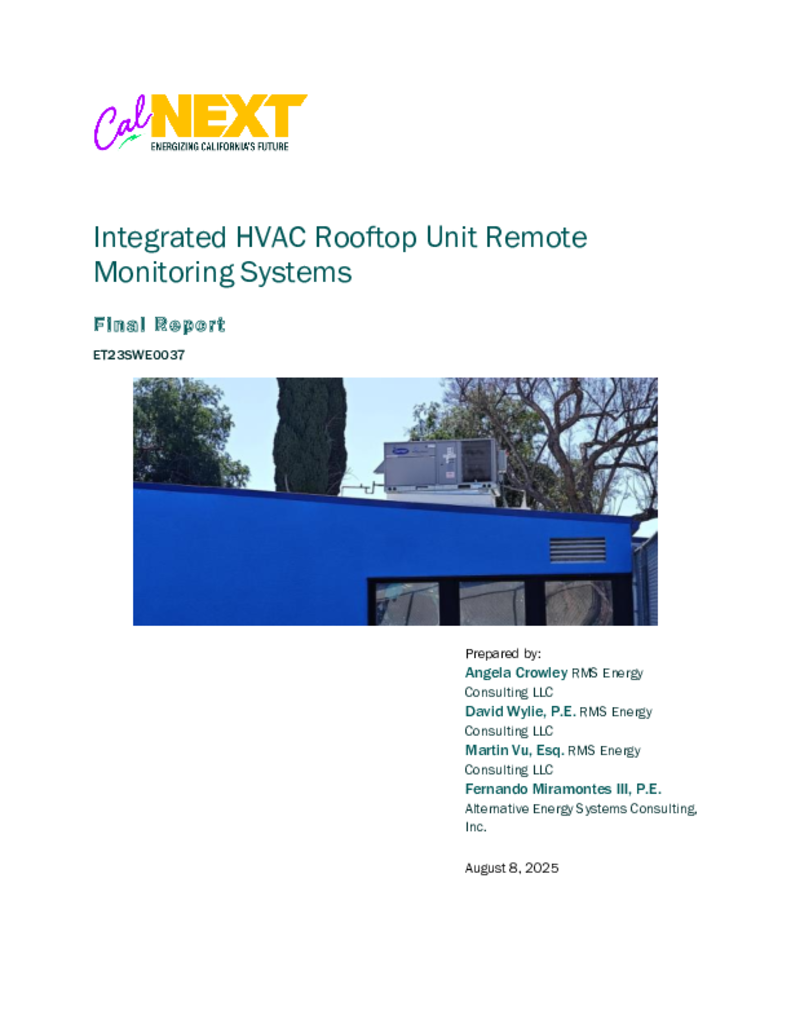ET23SWE0037 - Integrated HVAC RTU Remote Monitoring Systems
Many existing non-residential rooftop package units (RTU) including heat pumps do not have monitoring capabilities where temperature, pressure, and energy are known in real time. This is the typical case found in commercial primary and secondary schools within public school districts. The target market is commercial buildings with building types that use RTUs ranging between 3 tons to 20 tons. RTUs can be smaller or larger in size. However, the 3 to 20 tonnage range is the typical size seen in commercial buildings. For this TSR, the building type targeted will be primary and secondary schools within the Azusa or Chino School Districts.
The Integrated HVAC RTU Remote Monitoring System is the first of its kind and includes factory installed equipment where wiring and sensors are manufactured together with the new roof top package units (RTU) and heat pumps as a packaged solution. The factory installed equipment provides the wiring harness of sensors infrastructure with built in cloud-based monitoring capability that provides real time monitoring and status reporting on temperature, (outside, return and supply air) refrigerant suction and discharge pressure, electric energy, fan speed, economizer, and system status. These are standard data points for system operation status and are the same points of data that are evaluated when a technician puts instrumentation on at the site. The manufacturers for the factory installed monitoring system were identified. This integrated sensor option has just become available in 2023 and must be ordered with the equipment as a factory installed option. This makes available diagnostic data available at a fraction of the cost for in field installation of the same sensor points.
Functional Energy Efficiency Measures (EEM) Data Collected: Featured EEM benefits that will be used to estimate energy savings arise when HVAC equipment operates during unoccupied times including start and stop times, detects low refrigerant charge, low airflow, low ambient compressor operations (economizer faults), high condenser temperatures, and recommends timely demand response (DR) or load shifting opportunities, and is also capable of monitoring photovoltaics (PV) delivery, if installed. Upon receiving notice of faults, facility management and engineers (customers) at the applicable customer sites can review the fault diagnostic reports and correct the faults as appropriate. The project team will work closely with the facility management and engineering customers to define and detect appropriate tolerance ranges for applicable parameters monitored to ensure optimal operational conditions while achieving energy savings.
The system is ordered and manufactured at the factory for new RTUs. Because the factory installed equipment wiring harness infrastructure uses a BACNET communication platform, users have the option to adopt either the HVAC manufacturer’s cloud-based monitoring platform or communicate with other off the shelf software as a service (SaaS) cloud-based monitoring platforms using Wi-Fi to communicate alerts to users on computers, tablets, or smartphones. This compatibility flexibility allows users to lower the cost of monitoring communication platforms without concerns of data losses or not receiving important system performance alerts.
This project evaluated Carrier’s SystemVu, a factory-installed remote monitoring and AFDD platform for RTUs and heat pumps. SystemVu monitors over 260 operational variables and generates more than 100 alarm codes, enabling real-time diagnostics and maintenance tracking. It was paired with BEMA (BEMA 2025), a third-party cloud-based data acquisition system that analyzes equipment performance at one-minute intervals and issues alerts for faults and off-hours operation. Combined, these technologies support proactive maintenance strategies and drive energy savings.

